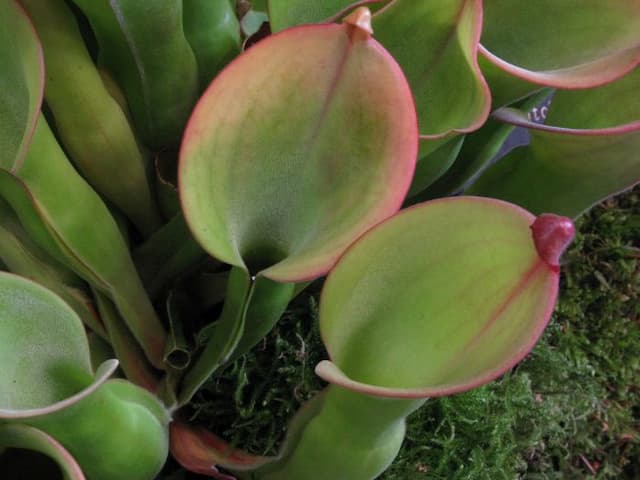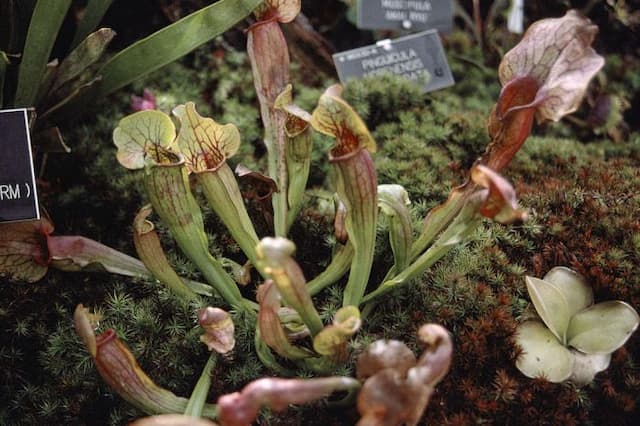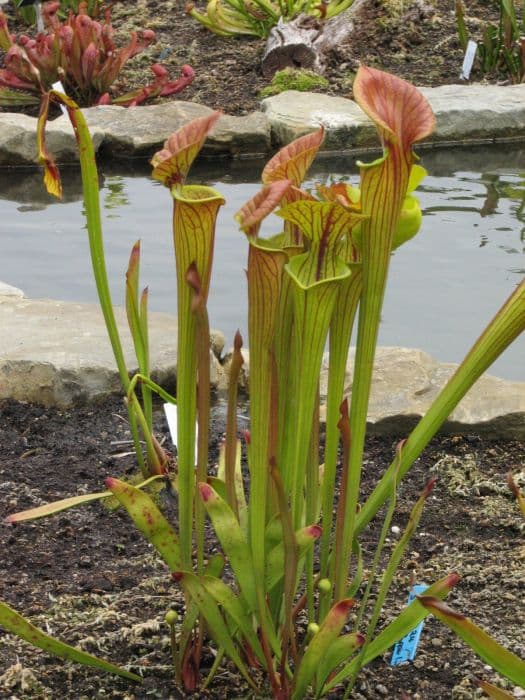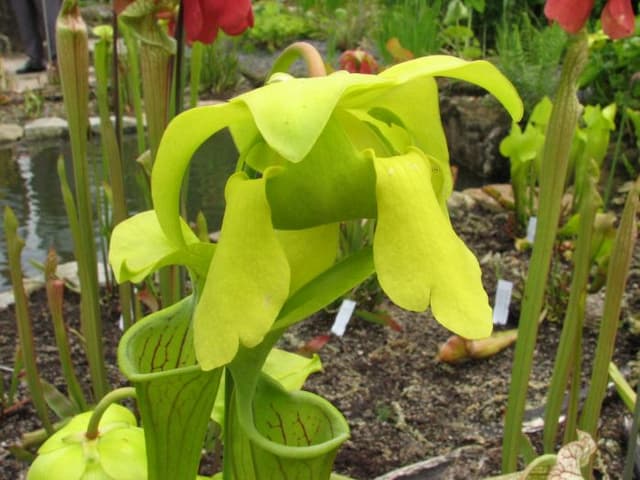Catesby's Pitcher Plant Sarracenia × catesbaei

ABOUT
The plant, commonly known as Catesby's pitcher plant, is a carnivorous species renowned for its unique and striking pitcher-like leaves. These leaves are tubular and typically showcase a range of colors, from deep reds to vibrant yellows and greens, often marked with attractive veining or speckling that serves both an aesthetic and a functional purpose, helping to lure in unsuspecting prey. The pitchers generally have a flared hood at the top, which overhangs the opening to shield it from debris and excess rainwater. Beneath the hood, the inner surface of the pitcher is often slippery and contains downward-pointing hairs, which prevent the escape of insects that are attracted to the plant's nectar. At the base of the pitcher, a pool of digestive enzymes awaits to break down the trapped insects, providing nutrients to the plant. The flowers of Catesby's pitcher plant also contribute to its distinctive appearance. They tend to be large and nodding, carried high above the foliage on strong stalks. The blossoms can be quite showy, displaying an umbrella-like structure with numerous petals arranged in a radial pattern. The petals are usually brightly colored, complementing the dramatic pitchers below. This plant truly embodies a blend of captivating beauty and functional adaptation, making it a remarkable specimen in any collection of carnivorous flora.
About this plant
 Names
NamesSynonyms
Catesby's Pitcher Plant, Hybrid Pitcher Plant.
Common names
Sarracenia × catesbaei.
 Toxicity
ToxicityTo humans
The Eastern Pitcher Plant is not commonly known to be toxic to humans. There are no prominent reports of poisoning from ingestion of the plant, and it is generally considered safe to handle. However, as with any non-culinary plant, it is recommended to avoid ingesting it due to the potential for unknown allergic reactions or irritation.
To pets
The Eastern Pitcher Plant is not commonly known to be toxic to pets either. It does not contain any known poisons that would be harmful to animals if they were to ingest parts of the plant. However, pets should not be encouraged to eat ornamental plants as they can cause gastrointestinal upset or an unexpected allergic reaction.
 Characteristics
CharacteristicsLife cycle
Perennials
Foliage type
Deciduous
Color of leaves
Varies
Flower color
Yellow-green
Height
1-3 feet [30-91 cm]
Spread
1-2 feet [30-61 cm]
Plant type
Herb
Hardiness zones
6
Native area
Southeastern United States
Benefits
 General Benefits
General Benefits- Attracts Pollinators: Lures and supports a variety of pollinators, such as bees and butterflies, enhancing pollination in the garden.
- Natural Pest Control: Helps reduce the number of unwanted insects by trapping and consuming them, which can benefit nearby plants.
- Educational Interest: The plant’s unique carnivorous nature makes it an interesting specimen for educational purposes, demonstrating unusual plant adaptations.
- Aesthetic Appeal: Offers visual interest with its distinctive pitcher-shaped leaves and vibrant colors, adding ornamental value to gardens.
- Conservation: As a hybrid of two native North American species, cultivating Sarracenia × catesbaei can contribute to the conservation of carnivorous plant species.
- Low Maintenance: Requires minimal care once established, as it is adapted to poor, nutrient-deficient soils where traditional plants might struggle.
- Drought Tolerant: Displays resilience in the face of dry conditions, making it suitable for xeriscaping and water-wise gardening practices.
- Habitat Creation: Provides a microhabitat for various small organisms, which contributes to biodiversity in the garden ecosystem.
 Medical Properties
Medical PropertiesThis plant is not used for medical purposes.
 Air-purifying Qualities
Air-purifying QualitiesThis plant is not specifically known for air purifying qualities.
 Other Uses
Other Uses- The Sarracenia × catesbaei, commonly known as the Pitcher Plant, can be used as a decorative element in carnivorous plant exhibits, showcasing the diversity of insectivorous plants and their unique adaptations.
- It can serve as an educational tool in biology classes to demonstrate evolution, specialization, and plant-animal interactions due to its insect-trapping mechanisms.
- The Pitcher Plant can be used in art installations and nature-inspired sculptures, where artists incorporate living plants into their work to challenge the traditional boundaries between art and nature.
- Enthusiasts of the Pitcher Plant may cultivate it for competitive horticulture, entering specimens into contests and exhibitions that judge the plants based on size, color, and form.
- This plant can be featured in themed gardens that focus on 'murderous' plants, appealing to those with an interest in the macabre aspect of nature.
- It can play a role in backyard ecology projects, attracting native insects and serving as a natural form of pest control.
- Photographers can use the Pitcher Plant as a compelling subject for macro photography, highlighting the intricate details and vivid colors of the plant.
- Insect enthusiasts may use this plant to observe and document the various species of insects it traps, contributing to local biodiversity studies.
- The Pitcher Plant can be incorporated into survival training programs to teach about the trapping of rainwater in its pitchers, which may potentially be a source of emergency drinking water if no other sources are available.
- Terrarium hobbyists might include the Pitcher Plant in their creations to add vertical interest and mimic a natural bog environment within a controlled, small-scale setting.
Interesting Facts
 Feng Shui
Feng ShuiThe Pitcher Plant is not used in Feng Shui practice.
 Zodiac Sign Compitability
Zodiac Sign CompitabilityThe Pitcher Plant is not used in astrology practice.
 Plant Symbolism
Plant Symbolism- Adaptation: Sarracenia × catesbaei, commonly known as Catesby's pitcher plant, thrives in nutrient-poor soils. Its adaptation to trap and digest insects symbolizes the ability to survive and prosper in challenging conditions.
- Uniqueness: The unique shape of Catesby's pitcher plant, with its tubular leaves and striking appearance, symbolizes individuality and the importance of standing out in a crowd.
- Mystery: Due to its carnivorous nature, Catesby's pitcher plant represents mystery and intrigue, highlighting nature's complex and often hidden strategies for survival.
- Balancing nature: As a carnivorous plant, it plays a role in controlling insect populations, symbolizing the concept of balance within an ecosystem.
 Water
WaterThe Yellow Pitcher Plant should be kept in damp soil, never allowing it to dry out completely. Water it using the tray method, where water is filled into a saucer beneath the pot, allowing the roots to soak up moisture from the bottom. This mimicking of its natural boggy habitat is crucial for its health. During the growing season in spring and summer, you might need to fill the tray with about 1 inch of water once or twice a week, depending on the temperature and humidity. Make sure to use distilled water or rainwater, as tap water often contains minerals that can harm the plant.
 Light
LightYellow Pitcher Plants prefer full, direct sunlight for healthy growth. A spot that provides at least six hours of direct sunlight, like a south-facing window, is best for these carnivorous plants, simulating their native environment in the sunny wetlands.
 Temperature
TemperatureYellow Pitcher Plants thrive in a temperature range of 70°F to 90°F during their growing season, but they can tolerate temperatures as low as 20°F during dormancy in the winter. It is important to mimic their natural cycle by providing a cold dormancy period.
 Pruning
PruningThe Yellow Pitcher Plant benefits from pruning to remove dead or decaying pitchers and to promote new growth. Prune in late winter or early spring, before the growing season begins. This annual pruning helps to maintain the plant's appearance and health.
 Cleaning
CleaningAs needed
 Soil
SoilThe pitcher plant thrives in acidic, nutrient-poor soil with a pH of 3.5 to 4.5. A common soil mix consists of equal parts sphagnum peat moss and perlite to ensure proper drainage and aeration.
 Repotting
RepottingPitcher plants, like Sarracenia × catesbaei, should be repotted every 2 to 3 years to refresh the soil and provide room for growth.
 Humidity & Misting
Humidity & MistingPitcher plants prefer high humidity levels, around 60-80%, to thrive and develop their characteristic pitchers properly.
 Suitable locations
Suitable locationsIndoor
Place pitcher plants in a bright area and maintain high humidity.
Outdoor
Ensure full sun, high humidity, and keep the soil moist.
Hardiness zone
5-9 USDA
 Life cycle
Life cycleThe Eastern Pitcher Plant, or Sarracenia × catesbaei, begins its life cycle when mature plants flower in the spring, producing showy, typically reddish flowers that attract pollinators. After pollination, seeds are produced and dispersed, which can germinate in suitably moist, acidic, and sunny conditions, like the boggy soils where this hybrid naturally occurs. Seedlings develop a rosette of small, pitcher-like leaves capable of trapping insects, which is crucial for obtaining nutrients in nutrient-poor soils. Through vegetative growth, the plant will develop larger and more numerous pitchers each year, increasing its ability to capture prey. The Eastern Pitcher Plant is perennial, surviving for several years by entering a period of dormancy during the cold winter months, only to resume growth when temperatures rise in the spring. As the plant matures, it can also propagate vegetatively by means of rhizomes, spreading and creating clumps of pitchers that continue the life cycle.
 Propogation
PropogationPropogation time
Spring-Early Summer
The trumpet pitcher plant (Sarracenia × catesbaei) is most commonly propagated through division, a method best performed in late winter to early spring before the plant emerges from dormancy. To propagate by division, carefully unearth the parent plant and gently separate the rhizome into sections, each with at least one growth point. These sections can then be potted individually in a mix specifically designed for carnivorous plants, which typically includes peat moss and perlite. It is important to ensure that the soil remains moist but not waterlogged and to provide the divisions with bright, indirect sunlight as they establish themselves. After a few weeks, the divisions should begin to show new growth, indicating that they have successfully started to root and establish themselves as new plants.









